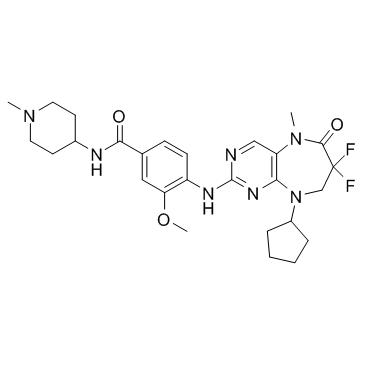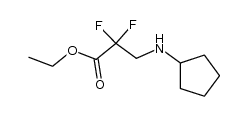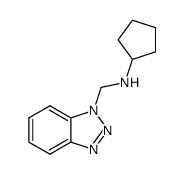Ro3280

Ro3280 structure
|
Common Name | Ro3280 | ||
|---|---|---|---|---|
| CAS Number | 1062243-51-9 | Molecular Weight | 543.609 | |
| Density | 1.4±0.1 g/cm3 | Boiling Point | N/A | |
| Molecular Formula | C27H35F2N7O3 | Melting Point | N/A | |
| MSDS | N/A | Flash Point | N/A | |
Use of Ro3280Ro3280 is a potent, highly selective inhibitor of PLK1 with an IC50 and a Kd of 3 nM and 0.09 nM, respectively, and nearly has no effect on PLK2 and PLK3. |
| Name | 4-[(9-Cyclopentyl-7,7-difluoro-5-methyl-6-oxo-6,7,8,9-tetrahydro- 5H-pyrimido[4,5-b][1,4]diazepin-2-yl)amino]-3-methoxy-N-(1-methyl -4-piperidinyl)benzamide |
|---|---|
| Synonym | More Synonyms |
| Description | Ro3280 is a potent, highly selective inhibitor of PLK1 with an IC50 and a Kd of 3 nM and 0.09 nM, respectively, and nearly has no effect on PLK2 and PLK3. |
|---|---|
| Related Catalog | |
| Target |
PLK1:0.09 nM (Kd) ALK:230 nM (Kd) CAMKK1:1100 nM (Kd) CAMKK2:87 nM (Kd) DAPK1:100 nM (Kd) DAPK3:70 nM (Kd) FER:53 nM (Kd) GAK:87 nM (Kd) MYLK:170 nM (Kd) PTK2:84 nM (Kd) PTK2B:130 nM (Kd) RPS6KA6 (KinDom.2):560 nM (Kd) TTK:51 nM (Kd) |
| In Vitro | Ro3280 (RO3280) inhibits PLK1 activity in NB4 and K562 cells, with an IC50s of 13.45 nM and 301 nM, respectively. RO3280 shows inhibitory activities against the growth of six leukemia cells, with IC50s of 186 nM, 175 nM, 74 nM, 797 nM, 120 nM and 162 nM for U937, HL60, NB4, K562, MV4-11 and CCRF cell lines, respectively. RO3280 also suppresses the growth of primary ALL and AML cells, with IC50s of 35.49-110.76 nM, and 52.80-147.50 nM, respectively. RO3280 (50 or 100 nM) induces apoptosis and cell cycle disorder in acute leukemia cells[1]. Ro3280 shows potent activity in H82, H69, A549 lung cancer cell lines with EC50s of 6 nM, 7 nM and 82 nM. Ro3280 also inhibits several other cancer cell lines, with low concentration[2]. RO3280 is cytotoxic to 5637 and T24 human bladder cancer cells, with IC50s of appr 100 nM. |
| In Vivo | Ro3280 (RO3280, 40 mg/kg, i.v.) inhibits 72% tumor growth in a mouse xenograft model implanted with HT-29 colorectal cancer cells, and when dosed more frequently, RO3280 completely suppresses the tumor growth[2]. RO3280 (30 mg/kg, once every 5 days, i.p.) shows significant anti-bladder cancer activities in a nude mouse model[3]. |
| Cell Assay | Leukemia cells or primary leukemia cells (2 × 104) are seeded in 96-well plates overnight and incubated with DMSO, or increasing concentrations of RO3280 (0.05-120 μM) for 24 h. The same volume of DMSO added to the vehicle treated wells. Each drug concentration is replicated four times. Then, 10 μL CCK8 solution is added to each well, incubated at 37°C for 2-4 h and the optical density (OD) values are measured at 450 nm using a scanning multi-well spectrophotometer. Relative survival rate is calculated from the absorbance values compared with the control group. The proliferation of cells is calculated as a percentage of the DMSO-treated control wells with 50% inhibitory concentration (IC50) values derived after plotting proliferation values on a logarithmic curve. The IC50 of PLK1 inhibitor is calculated by Graph Prism software[1]. |
| Animal Admin | Briefly, mice (female, 4-5 weeks of age) are used in the assay. Cells (5 × 106 cells in 150 μL) are suspended in RPMI 1640 and injected subcutaneously into the flank of each BALB/c nude mouse. On day 5, tumour size is measured, the animals are randomized into two groups (n = 15 per group), and RO3280 (40 mg/kg, once every 5 days) treatment is initiated by intraperitoneal injection. The control group is treated with vehicle (1.5% DMSO in PBS). The drug (or vehicle) treatment is performed for 40 days. The length and width of the resulting tumours (in millimetres) are measured every 3 days with callipers. The tumour diameter is measured, and the volume (length × width2 × 0.52) is calculated. The mice are humanely killed on day 45, and the tumours are dissected and weighed. Western blot and immunohistochemistry assays are also performed with these sections. Then, the tumours are fixed, embedded and cut into 3‐μm‐thick sections, which are subsequently stained with haematoxylin and eosin to permit the observation of the tumour margin[3]. |
| References |
| Density | 1.4±0.1 g/cm3 |
|---|---|
| Molecular Formula | C27H35F2N7O3 |
| Molecular Weight | 543.609 |
| Exact Mass | 543.276917 |
| PSA | 106.42000 |
| LogP | 1.19 |
| Index of Refraction | 1.623 |
| Storage condition | -20℃ |
| Benzamide, 4-[(9-cyclopentyl-7,7-difluoro-6,7,8,9-tetrahydro-5-methyl-6-oxo-5H-pyrimido[4,5-b][1,4]diazepin-2-yl)amino]-3-methoxy-N-(1-methyl-4-piperidinyl)- |
| 4-(9-cyclopentyl-7,7-difluoro-5-methyl-6-oxo-6,7,8,9-tetrahydro-5H-pyrimido[4,5-b][1,4]diazepin-2-ylamino)-3-methoxy-N-(1-methyl-piperidin-4-yl)-benzamide |
| 4-{[(9-anthrylmethyl)amino]carbonyl}phenylboronic acid |
| Boronic acid,[4-[[(9-anthracenylmethyl)amino]carbonyl]phenyl] |
| 4-[(9-Cyclopentyl-7,7-difluoro-5-methyl-6-oxo-6,7,8,9-tetrahydro-5H-pyrimido[4,5-b][1,4]diazepin-2-yl)amino]-3-methoxy-N-(1-methyl-4-piperidinyl)benzamide |
| Ro3280 |

![4-(9-cyclopentyl-7,7-difluoro-5-methyl-6-oxo-6,7,8,9-tetrahydro-5H-pyrimido[4,5-b][1,4]diazepin-2-ylamino)-3-methoxy-benzoic acid structure](https://image.chemsrc.com/caspic/038/1062243-48-4.png)

![3-[(2-chloro-5-nitro-pyrimidin-4-yl)-cyclopentyl-amino]-2,2-difluoro-propanoic acid ethyl ester structure](https://image.chemsrc.com/caspic/253/1062245-99-1.png)

